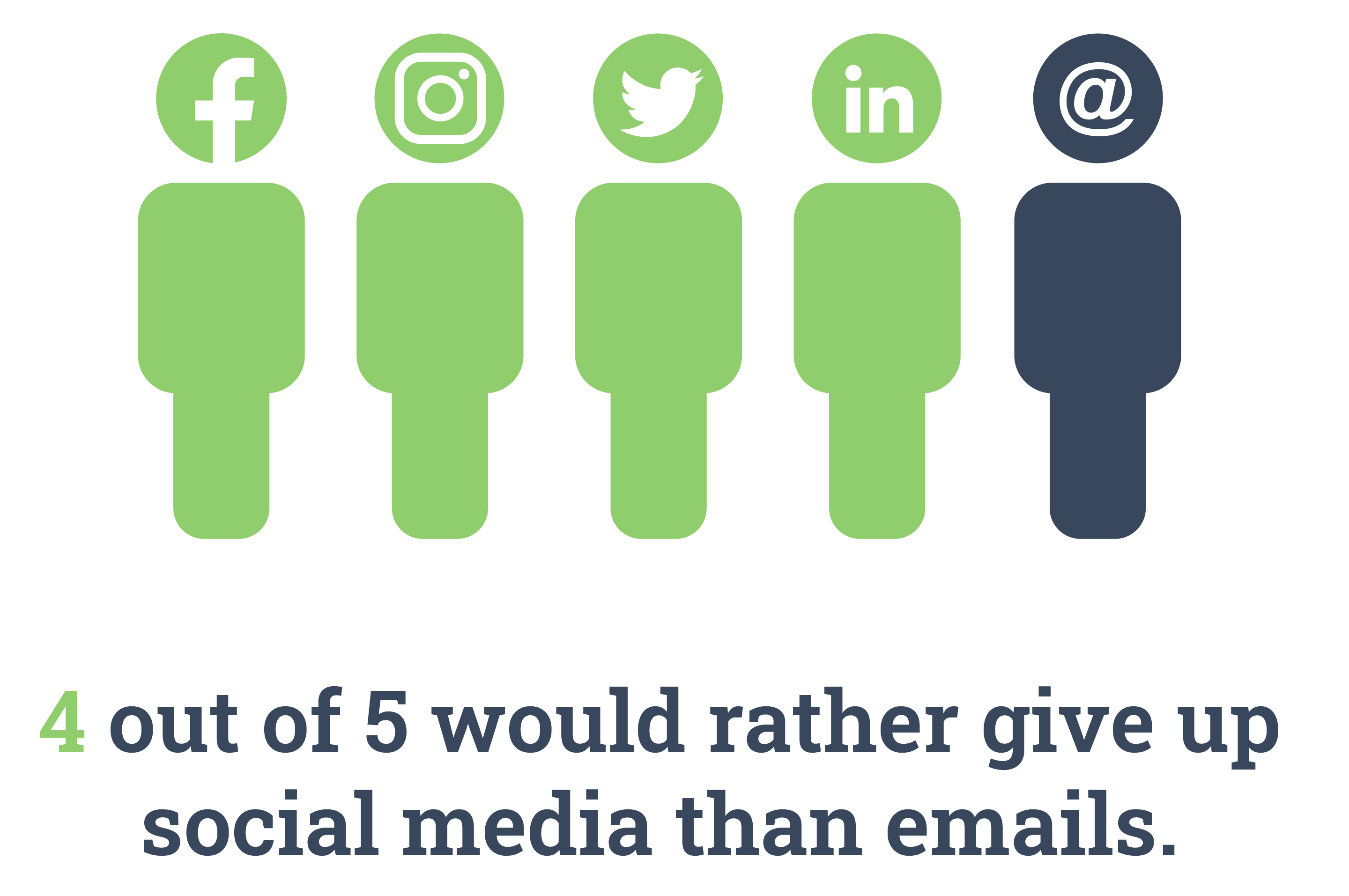How Apple’s iOS 15 Update Will Affect Your Email Marketing
For several years now, the phrase “email marketing is dead” has plagued marketers across the globe. Since the digital transformation and the explosion of social media, there has always been an underlying uncertainty around the impact or, lifespan of this channel.
Despite this, however, email marketing has proven resilient with 29% of businesses rating email as their most successful channel and 78% of marketers seeing a consistent increase in engagement throughout 2020.
Emails are still an essential communication channel for businesses globally, with 4 out of 5 marketers stating that they would rather give up social media than emails. However, with the latest Apple iOS 15 update, it’s important to consider how this might change the state of play for email marketing. Could this spark the end of this communications channel as we know it?
Keep reading to discover everything you need to know about Apple’s recent privacy updates, how this could be impacting your email marketing, and how to adjust your current strategy to prevent negative implications.
What is the Apple iOS 15 update?
Since its early beginnings, Apple has been introducing ongoing system updates to improve user experience and innovate. In September 2021, the tech giant started rolling out its latest version, iOS 15, with a focus on cracking down on data privacy.
There are a number of changes users will see, from a newly designed UI to an integration between memories and music, as well as 3D map views. However, what’s most significant to us as marketers is their privacy updates, specifically in the mail app, which aims to give power and control back to the user.
As part of the new update, Apple mail users have the option to opt out of sharing their data with the choice to “protect mail activity” from marketers. If they choose this option all user mail activity will be loaded remotely, protecting the recipient's IP address. As well as this the new update will impact the content that can actually be included in emails.
With multiple privacy updates in recent years and the general public becoming more tech-savvy than ever, this update really is no surprise. The rise in working from home has resulted in many receiving a crash course in cyber security, making this once niche concern become something much more mainstream.
Although this update will only affect Apple users, it’s estimated that Apple mail and Apple users make up, on average, 30-50% of the average business’s email list with 1 billion people worldwide using an iPhone.
There is the option to opt-out of this feature, however, if the past is anything to go by when given the option, most users will choose to protect their data from businesses. For example, with the iOS 14 update, a whopping 96% of U.S. users chose not to opt-in to app tracking, showing just how much consumers value their privacy.
The 3 key impacts on email marketing
There are three key changes that will impact email marketers. It’s worth noting that two of these changes are currently only available to iCloud+ subscribers but, it’s anticipated that these will become more widely available in years to come.
1) Mail privacy protection
The new privacy updates will eliminate the ability of businesses to accurately track whether emails have been opened by their contacts.
2) Private relay will hide the user’s IP address while browsing the web (iCloud+ subscribers)
This feature is specifically designed to protect the consumer’s identity when browsing the web using Safari. All traffic is run externally through two Apple servers, allowing the user's identity, web address, and IP address to be masked.
3) Hide my email will allow users to mask their real email address with a fake one (iCloud+ subscribers)
This feature allows Apple email users to create unique and random email addresses to use across the web whether just browsing, checking social media, and more.
How to navigate your email marketing going forward
Firstly, email marketing isn’t dead. Kate Nowrouzi, VP of Deliverability at Pathwire highlighted that the ability to mark emails as spam didn’t kill them and this new update should merely be a “wake-up call for marketers” to adapt their strategy.
With this in mind, there are several steps you can take to limit any negative impact of the new iOS update and pivot your email marketing strategy for success.
1) Turn your focus away from open rates
Essentially, in protecting their data, customers will impact their open rates. Although open rates aren’t gone, they will no longer be an accurate measure of engagement.
Open rates traditionally have been the key metric that marketers have relied on to track the effectiveness of their emails, test subject lines, and gauge who their most active subscribers are. They also have been fundamental in segmenting audiences and running retargeting campaigns, triggering automated “follow-up” campaigns.
But now, with the majority of audiences untrackable, open rates have become unreliable. By masking recipient data and downloading content through a secondary IP address, marketers no longer have trustworthy data on how many of their contacts actually opened their emails.
So what can you do?
Although open rates have become unusable, there are other metrics you can monitor to track email success and customer engagement, such as:
- Clickthrough rates (a general percentage)
- Those who visit your website (a specific list)
- The size of your email list
- Signups for events, webinars, etc.
- Survey data
- Purchases and orders
- Subscriber lifetime value
These metrics have always served as a way of monitoring customer intent, however with open rates gone, it’s crucial that you start incorporating some of these factors into your reporting and planning if you haven't done so already.
It’s also worth reviewing your current marketing automation. Many businesses will have email workflows that are triggered by email opens and so these will need to be adjusted to more accurately reflect user behaviour.
2) Revisiting old tried and tested techniques
In many ways, the new update seems like a step back for marketers who have been using customer data to build highly personalised and interactive email content. This has always been considered as a more innovative way to ensure consumers are receiving content that is most relevant to their interests.
On paper, this kind of personalisation sounds like a win-win for everyone - consumers receive communications from businesses that are actually relevant and, businesses aren’t wasting time or resources annoying disinterested contacts. Therefore, the new update has been somewhat of a shock to the system.
Email marketers should try to look back and analyse their historic data. Consider what campaigns and communications were most effective before the days of “data-driven workflow automation”.
For example, iOS 15 has resulted in the removal of countdown timers, commonly used to remind customers about sales or build excitement before an event. With this feature now gone, marketers will have to revert to the traditional reminder emails in order to build this same kind of urgency.
You may find that consumers engaged most with biweekly emails rather than weekly or, that they preferred plain text rather than leading with images. By considering old techniques, you may discover valuable insights that will prevent you from starting into any new strategy completely blind.
3) It’s time to cleanse your data
We’re all guilty of falling behind on cleaning up our marketing lists, holding on to contacts who you hope will come back someday. Especially when you consider that email lists decline by around 20–30% every year. If you aren’t regularly monitoring your contacts, you likely will have many inactive contacts in your lists.
Thanks to the new iOS update, marketers are going to find this task even more difficult due to the uncertainty around who is actually an active subscriber in your contacts.
Cleansing your email list may seem like an insurmountable task, especially if you have built up years of contacts. However, there are some simple steps you can take to create more reliable and structured email lists going forward.
Firstly you should take a deep dive into the reports from your recent emails, who actually engaged with the content, and whether anyone reported the email as spam. From this, you will recognise contacts who are consistently unengaged and therefore, have no business cluttering up your contact lists. It was found that only 13% of people believe that over half of their marketing emails from brands are actually useful. This is a time to be ruthless - there’s no point reaching out to contacts who are never going to take action.
At this stage, you should also check that all your contacts have given the proper consent. Over the years, like with the Apple update, there have been continuous legislative updates to ensure consumer data is protected. GDPR (General Data Protection Act) was created as part of The Data Protection Act 2018 and changed how companies handle, process, and share customer data. The majority of businesses will now be compliant with these standards by this stage, however, it is worth reviewing your mailing lists to ensure you are up to date with the most recent legal requirements.
Once you have a list of cleansed contacts you can begin segmenting them effectively based on their previous behaviour, whether this is website visits, purchase history, or content downloads. By creating highly targeted lists you are ensuring your contacts are receiving only the most relevant content even after the update and increasing the chances of them engaging.
You can take this a step further and email your database of current contacts with a survey to find out what communications they are most interested in and how they prefer to be contacted. This removes any guesswork and ensures you are segmenting your contact list with the most up-to-date data.
You may also find some contacts who prefer not to be contacted or do not understand how they ended up on your mailing list. As mentioned, this is an opportunity to remove uninterested contacts and ensure your business is compliant with GDPR.
Once you have created your survey, this could become part of your first automated email triggered to all new contacts going forward to help ease your segmentation process.
There are endless reasons why you should maintain a healthy email list, but this has become especially important thanks to the new iOS update. With a clean database full of highly engaged contacts, and an understanding of their preferences you can be sure to see an increase in your KPIs.
4) Always space to innovate
Although the update may feel like a major upheaval for marketers, creating an unsettling level of uncertainty, it presents a new opportunity to innovate and find new ways to reach customers and build loyalty.
Particularly with the highly turbulent year created as a result of the pandemic, patterns, information and direction have been severely lacking and therefore, the push for marketers to innovate has been inevitable.
To stay ahead of the change, marketers should brainstorm new ways to collect consumer data directly.
As mentioned previously, the Apple update does not shatter email marketing or data collection, it simply gives the control back to the consumer so they can share, or hide as much as they please. Therefore, it is the task for marketers to ease consumer fears and prompt them into handing over their data willingly.
Salesforce found that 57% of consumers are willing to share personal data in exchange for personalised offers or discounts. Similarly, 52% of consumers would share personal data in exchange for product recommendations, and 53% would do the same for personalised shopping experiences.
It’s evident that consumers do feel comfortable sharing personal data. What’s important, however, is that they feel there is value in return and that the communications are relevant. Interestingly, 72% of Americans admitted they were reluctant to share information with businesses simply because they “just want to maintain their privacy.”
With this in mind, there are endless possibilities for marketers but the key is to earn customer trust. This can be achieved through thoughtful planning, getting to know your email subscribers, learning from your KPIs, and continuing to create relevant and useful content.
Book a free demo of Hurree today and discover how to truly harness the power of analytics and transform your company reporting using cross-platform dashboards. If you have any questions then feel free to reach out to contact@hurree.co, we'd be happy to answer them!
Share this
You May Also Like
These Related Stories

Beginner's Guide to Creating a Profitable Email List

How to Boost Your ROI with Email Marketing Automation




